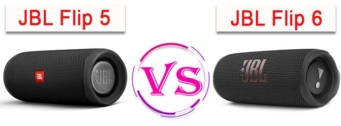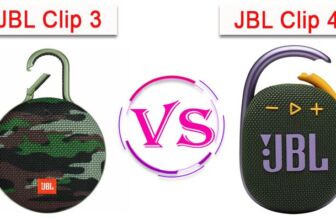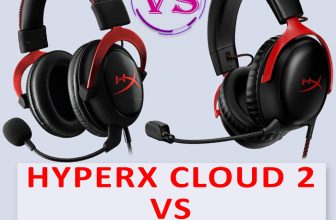If you are looking for the comparison between the JBL Charge 4 and 5, it means that you are familiar with the JBL’s quality and style. Now it’s time to investigate the new output and set it side by side with the earlier product.
Beyond a doubt, the fresh model of the JBL Charge speakers, the Charge 5, beats all predecessors by its sound quality and unquestionable design. The clash of the JBL Charge 4 vs Charge 5 will reveal the difference between the two speakers.
Even though the upgrade requires some extra funds, is it still worth getting? Or would you consider affordability as a vantage for picking the Charge 4? Let’s hear these differences out.
Table of Contents

The JBL Charge 4 vs Charge 5
Quick Summary
Undeniably that the JBL wouldn’t produce a most recent device without putting in substantial details. The Charge 5 outputs improved sound by equalizing different frequency tunes. You may not feel any difference with the Charge 4, but it’s significant while testing for hard and soft music.
When taking these gadgets for events, the latest model can be connected to Party-Boost-featured speakers. However, it can’t playback music with other speakers through Connect+, unlike the Charge 4. Even more, the Charge 5 may delay while connecting to devices, but it varies within apps.
The recent portable Bluetooth speaker was set to be water- and dustproof as it is IP67 rated. So, if somehow the speaker falls underwater, have no fear; it’ll work just fine.
This is just a short overview of some renovations to the Charge 5 device. See the comparison battle of the JBL Charge 4 vs Charge 5 and scroll down to deep in the world of the JBL’s technologies.

The JBL Charge 4
View on Amazon: JBL CHARGE 4 Portable Bluetooth Speaker

The JBL Charge 5
View on Amazon: JBL CHARGE 5 Portable Bluetooth Speaker
The JBL Charge 4 vs 5: Comparison Chart
Name | JBL Charge 4 | JBL Charge 5 |
MUSIC | ||
EQ | Graphic | |
Speakerphone | ||
SOUND | ||
Frequency Response Range | 61.7 Hz to 7.9 kHz | 58.2 Hz to 18.5 kHz |
Sound Level (Good <3.4 dB) | 5.32 dB | 3.90 dB |
Output Power | 30 watts | 40 watts |
BUILD QUALITY | ||
Material Quality | Great | Great |
Water Resistance | Submersible (IPx7) | Submersible (IPx7) |
Dust Resistance | Unspecified | Dust-Proof (IP6x) |
BATTERY | ||
Battery Life | 13.1 hrs | 14.5 hrs |
Charge Time | 4.0 hrs | 3.8 hrs |
Power Saving | ||
Changing Port | USB-C | USB-C |
VOICE ASSISTANT | ||
Alexa | ||
Google Assistant | ||
Siri | ||
Voice Activation | ||
APP | ||
App Name | JBL Portable | JBL Portable |
iOS | ||
Android | ||
Stereo Pair Mode | ||
Party Mode | ||
Multi-Room | ||
BLUETOOTH | ||
Bluetooth Version | 4.2 | 5.1 |
Bluetooth iOS Latency | 16 ms | 125 ms |
Bluetooth Android Latency | 15 ms | 102 ms |
Bluetooth Range | 334.6 ft (102.0 m) | 328.1 ft (100.0 m) |
Multi-Device Pairing | 2 Devices | 2 Devices |
Wi-Fi | ||
Wi-Fi version | ||
WIRED | ||
Aux Imput | ||
USB Audio | ||
Other Port | ||
PORTABILITY | ||
Volume | 119 in3 (1,943 cm3) | 121 in3 (1,982 cm3) |
Weight | 2.0 lbs (0.9 kg) | 2.0 lbs (0.9 kg) |
Power Source | Battery & USB | Battery & USB |
Features Face to Face
We’ll look at some features like sound quality and durability, battery capability and overall connectivity, check for design and portability of these Bluetooth speakers.
Sound Quality
In general, the audio quality is very similar for both portable speakers. Nevertheless, it feels purer on the last model, when the volume is about 50%. However, both of them begin to distort the sound when it comes to raising the volume up to 80% and more. The users observed the hissing and reduced bass sound.
The output power is between 30 and 40 watts for these speakers making no significant difference in terms of the spectrum of playback sound. The frequency response range is one step ahead for the Charge 5, making better sound quality. It’s well noticeable when the heavy bass tunes sound cleaner and mid/high voices resonate with the real musical notes of the song. Additionally, when it’s outdoor, the Charge 5 is incredible and loud, but it’s specific and experiences different for everybody.

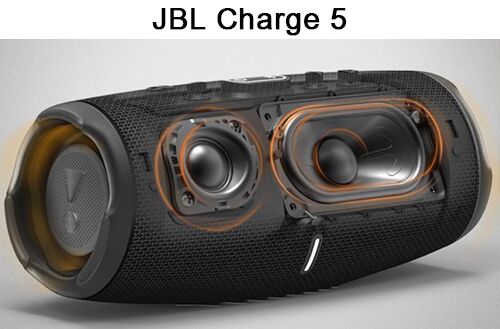
Button Accessibility
Both gadgets have nice and comfortable button arrangement, as all JBL products do. Specifically, you won’t see any essential changes at this point for the Charge 5 model, which is upstanding.
On the left far of the speakers, there’s a button to link to other JBL devices; its appearance slightly differs within two speakers. Next to it, you’ll see the Volume Down button together with the Power and Bluetooth buttons placed on the rubber pad in the middle of this line. Then, the Volume Up and Pause buttons sit on the right side of the row.
The ease and convenience are highly benefited these Charge speakers over the others.
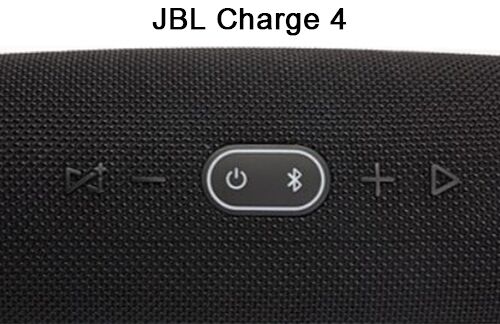
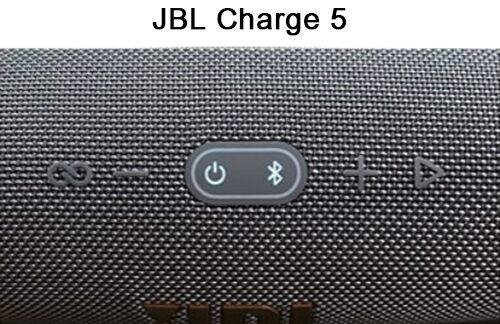
Software
The great advantage of these devices is that they can be connected to multiple speakers. Thanks to Connect+ and PartyBoost apps, the user is able to link up to 100 speakers at the same time. The JBL made a change between these apps allowing the speakers to be linked on a maximum distance equal to 40 yards (35 meters) for the Connect+. On a contrast to PartyBoost, this number is twice increased and equivalent to 80 yards (70 meters). Indeed, these figures are approximate and work for areas clear from impediments.
To compare, in the duel of the JBL Charge 4 vs 5, the former edition has a Connect + app, while the recent one uses a PartyBoost app, meaning these two are not compatible as the JBL permits to link devices only within one app. In other words, the user can connect the JBL PartyBoost speaker via Bluetooth with the one using the same app.
Durability
Both speakers are sturdy enough to operate fine in case of knocking over. The latter version got few improvements, having a little more rubbering in some spots; however, this can’t be considered a substantial upgrade compared to the Charge 4.
The difference between the Charge 4 and 5 is the stand. The Charge 4 has a narrowing plastic base that sits at the bottom. Instead, the Charge 5 holds ridged rubber lines that run diagonally. Having this said, many users noticed that the newer product is more stable in rough conditions.
The JBL Charges gadgets are featured to operate while submerged in 1 meter of water for 30 minutes being IP7x rated, which stands for water resistance. As for dust-proof classification, the Charge 4 cannot brag about it. Alternatively, the Charge 5 is IP6x rated, making it a reliable companion for outdoor events.
Design Features
The JBL Charge 4 and 5 have almost equal size and weight numbers having no visual differences at these points. These speakers look nice, and it’s comfortable to hold them. Their exterior is covered with a wired mesh which makes a rigid structure enclosing the internal parts. This design keeps devices safe and tolerates from tough environment.
The rubber end caps on the new version bulge out from the speaker, meaning if you put it vertically, the device will lean to one side. Moreover, there’s more rubber on the cap ends for the Charge 5 in a contrast to the prevailing plastic material for the Charge 4, which makes it prone to be cracked.
The external passive radiators of both speakers look the same in size and shape, though it feels more sturdy in the Charge 5 than in the Charge 4. We mean that both of them are tough, but the latter one’s is considered tougher.
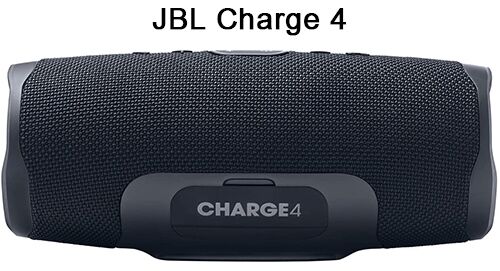
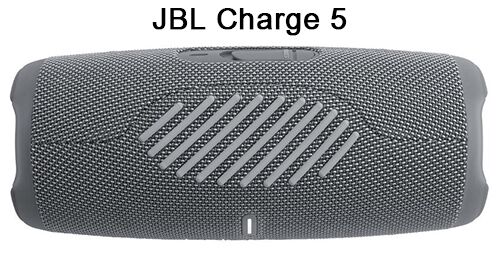
Check Latest Price: JBL CHARGE 4
Check Latest Price: JBL CHARGE 5
Portability and Battery Power
The speakers are a great option to be taken outside for the events and portable enough for one-hand carry. The recent product is a bit lighter, but it doesn’t make much deal.
The battery capacity is the same for both models and is equal to a 20-hour run time. It’s worth mentioning that these speakers can charge other devices as most JBL products do; however, the battery life significantly decreases taking off 5 hours of run time. Plus, take into consideration that high volumes also pull the power crucially. To extend the capacity of your speaker for 12 hours, turn the sound level down up to 30-40%.
The time to charge these gadgets is also the same, approximately four hours. The battery power is presented differently in the Charge speakers. The past version had five lights that indicated the battery status. The more glowing lights are green, the fuller the battery is. After that, the lights blink red, signaling the low battery.
On the other hand, the Charge 5 has a vertical LED light bar beneath the central JBL logo. Once it is fully charged, this indicator is alight. With the use of the speaker, the battery life decreases, and the red light again shows the low charge.
As for Bluetooth versions, the Charge 4 uses 4.2, and the Charge 5 gets 5.1, respectively. It means that the last model should have a prolonged battery life compared to the previous one. Bluetooth 5.1 uses less power than its predecessor. Furthermore, it grants better wireless connection, offering higher data transfer rates.
Connectivity
None of the speakers provide the integration of Google Assistant or Apple Siri and they don’t have a microphone to pick up phone calls on the device.
There is no 3.5 mm audio cable input on the Charge 5 compared to the Charge 4, so this should be taken into consideration while purchasing a product. The USB type C port exists for both model; however, its location differs. For the Charge 4, it’s found under the port cover on the back of the speaker, whereas for the Charge 5, it’s based next to the port cover. The USB type A opening for these two is placed under the port cover. The main purpose of it is to charge other devices.
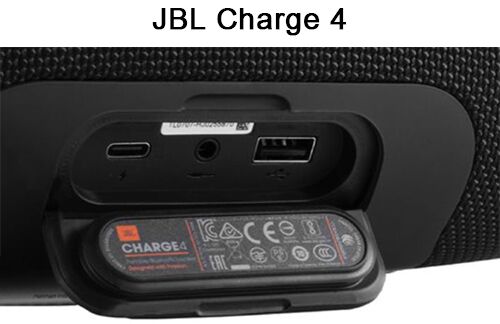
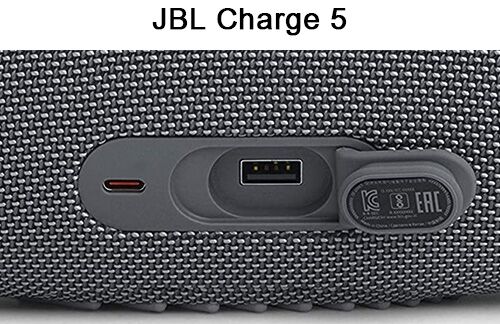
Uses
Both versions are portable, so they can easily be taken to any outdoor events, like beach and pool parties. The users should not be worried about water or dirt pollution because of their resistance to some/all factors. Also, these speakers operate well while inside of the building, like in a house or gym. They are characterized by lifesaving option as they can charge your phone during these events.
Summing up
These two portable Bluetooth speakers have outstanding monstrous sound! They both can supplement great your trips, any outdoor and indoor events. Nonetheless, keep in mind that these devices are not compatible speakers as they have different software: Connect + for the Charge 4 and PartyBoost for the Charge 5.
Specifically, you should listen to yourself and choose the main qualities you’d like to have while purchasing. Features like aux jack, wide Bluetooth range, hisser bass sound, covered ports, lower Bluetooth latency, modest design, and affordable price will compel to get the Charge 4.
We talked so much about the JBL’s newborn, so it’s time to outline its characteristics. So, the Charge 5 will be an excellent addition for any occasion being water and dust proof. Its magnificent and clean sound fills out every space it is in, together with stylish design catching everybody’s eyes on. Have in view, its audio port has been removed and the latency to devices is higher, though some apps can compensate for it. The price rose mainly for sturdy durability and neat sound.
Check Latest Price: JBL CHARGE 4
Check Latest Price: JBL CHARGE 5
All that being said, in the clash of the JBL Charge 4 vs Charge 5 the latest product gains a point, especially if you are a valid follower of the JBL technologies. We hoped that you have heard the differences between these products. So, it’s just time to get one.

